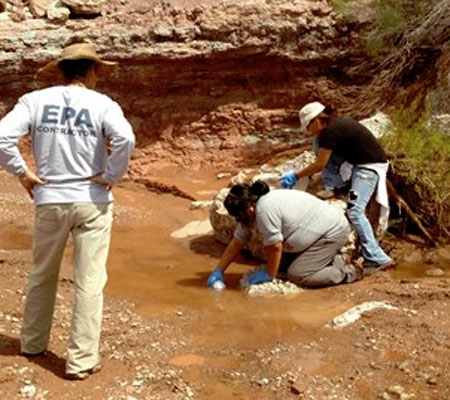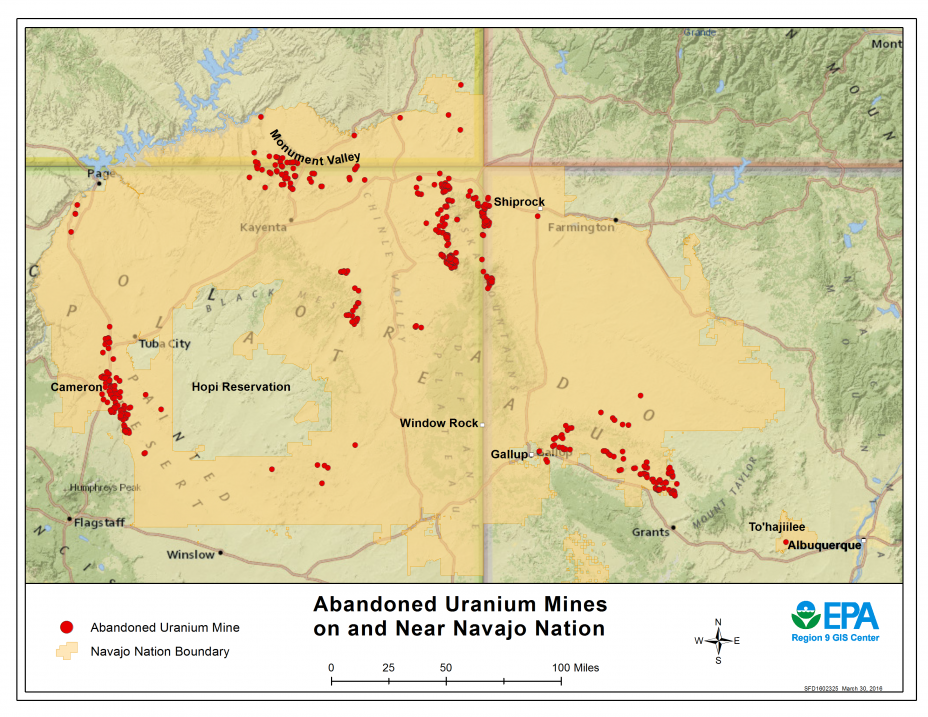Abandoned Mines Cleanup
There are over 500 abandoned uranium mines on Navajo Nation. This page provides information about contamination from the mines and how it is being addressed.
 Diné College interns with EPA sampling team conducting Cove Wash watershed assessments in March, 2016.
Diné College interns with EPA sampling team conducting Cove Wash watershed assessments in March, 2016.Background
From 1944 to 1986, nearly 30 million tons of uranium ore were extracted from Navajo lands under leases with the Navajo Nation. Many Navajo people worked the mines, often living and raising families in close proximity to the mines and mills. Today the mines are closed, but a legacy of uranium contamination remains, including over 500 abandoned uranium mines (AUMs) as well as homes and water sources with elevated levels of radiation. Potential health effects include lung cancer from inhalation of radioactive particles, as well as bone cancer and impaired kidney function from exposure to radionuclides in drinking water. Learn more about health effects of uranium and how you can avoid contact with it.
EPA maintains a strong partnership with the Navajo Nation and, since 1994, the Superfund Program has provided technical assistance and funding to assess potentially contaminated sites and develop a response.
Settlements
EPA has entered into enforcement agreements and settlements valued at over $1.7 billion to reduce the highest risks of radiation exposure to the Navajo people from AUMs. As a result, funds are available to begin the assessment and cleanup process at 219 of the 523 abandoned uranium mines. The Abandoned Uranium Mine Settlement fact sheet provides information on the separate enforcement agreements and settlements to address abandoned uranium mines on the Navajo Nation. To learn more about EPA’s Superfund legal agreements please visit Negotiating Superfund Settlements.
Five-Year Plan
In October 2007, at the request of the U.S. House Committee on Oversight and Government Reform, EPA, along with the Bureau of Indian Affairs (BIA), the Nuclear Regulatory Commission (NRC), the Department of Energy (DOE), and the Indian Health Service (IHS) developed a coordinated Five-Year Plan to address uranium contamination in consultation with Navajo Nation EPA (NNEPA).
In 2014 a second Five-Year Plan was created which built upon the work done during the first five years, and established objectives and strategies to address the most significant risks to human health and the environment.
Recent News
Priority Mines
EPA and NNEPA prioritized 46 mines (called priority mines) based on gamma radiation levels, proximity to homes and potential for water contamination identified in preliminary assessments documented in our Site Screen Reports. Detailed cleanup investigations will be conducted at these mines by 2018.
All 46 priority mines are in the assessment phase which includes biological and cultural surveys, radiation scanning, and soil and water sampling. These assessments help to determine the extent of contamination. The assessment work at the 46 priority mines will be documented in Removal Site Evaluation reports which will be completed by the end of 2018. These reports will be shared with communities and made available on our website.

